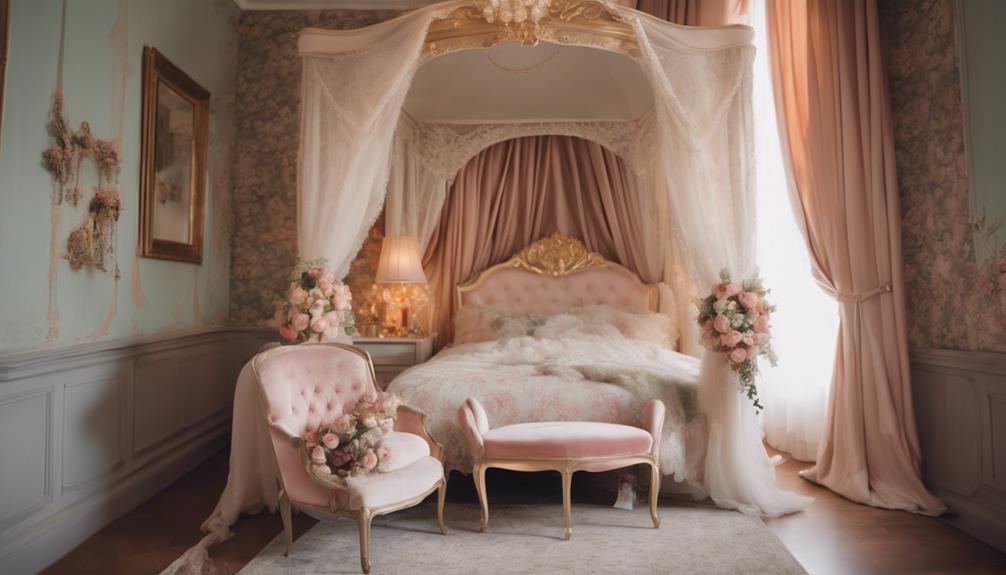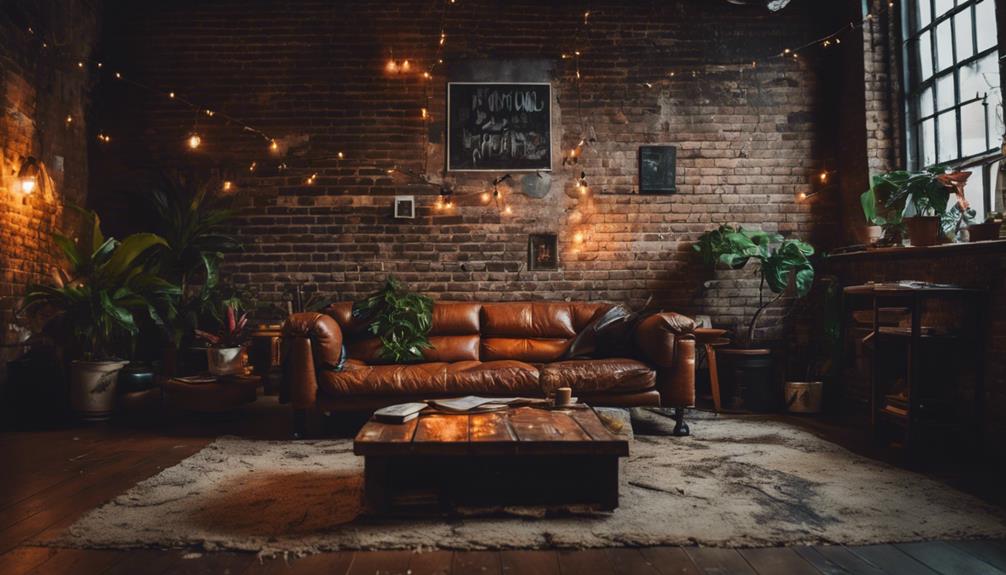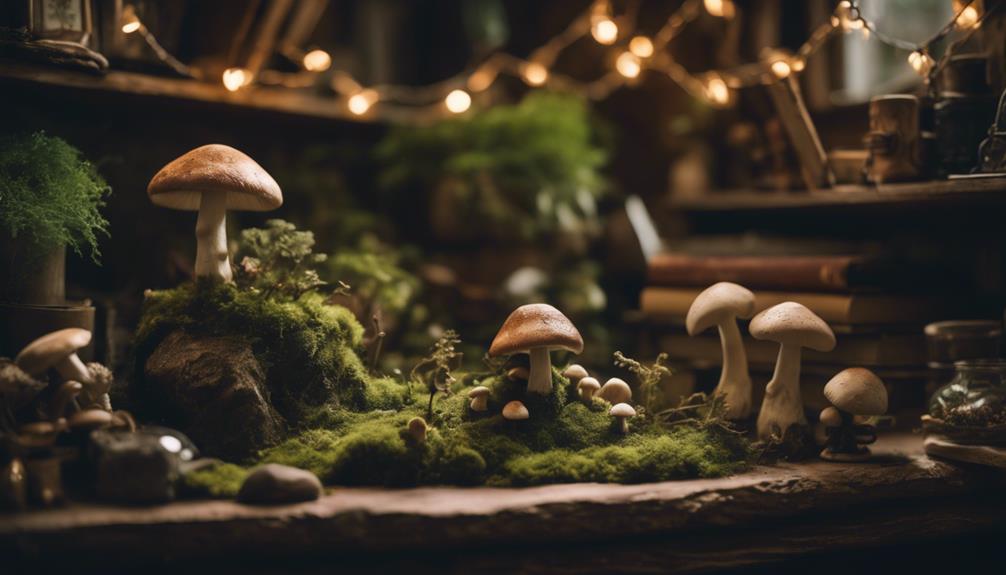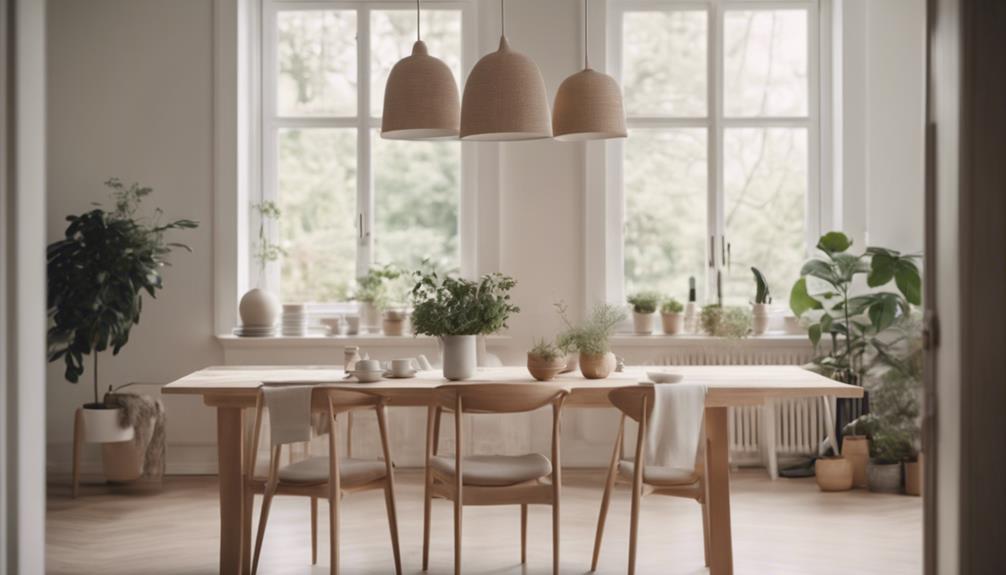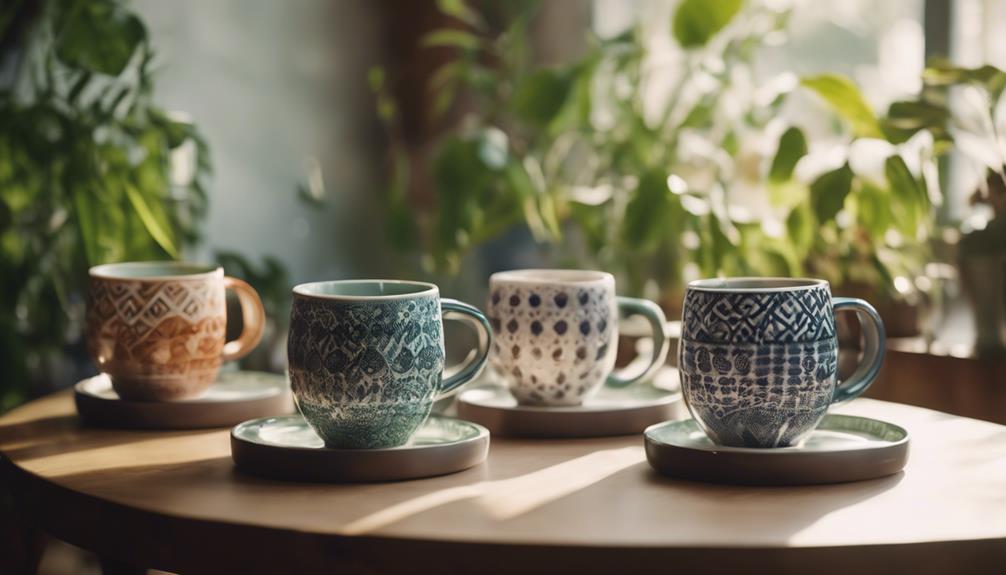To create an aesthetic coquette bedroom, start by choosing soft pastels like blush and cream for your color scheme. Incorporate vintage-inspired furniture, such as a charming vanity table or an elegant French armchair, to add character. Layer textiles like lace-trimmed bedding and floral-patterned throw pillows for a cozy touch. Use warm, inviting lighting with soft pink lamps or delicate fairy lights to enhance the romantic vibe. Don't forget to select a beautiful area rug that complements your decor. With these tips, you'll craft a dreamy space that feels both charming and cohesive, so keep exploring for more inspiration!
Key Elements
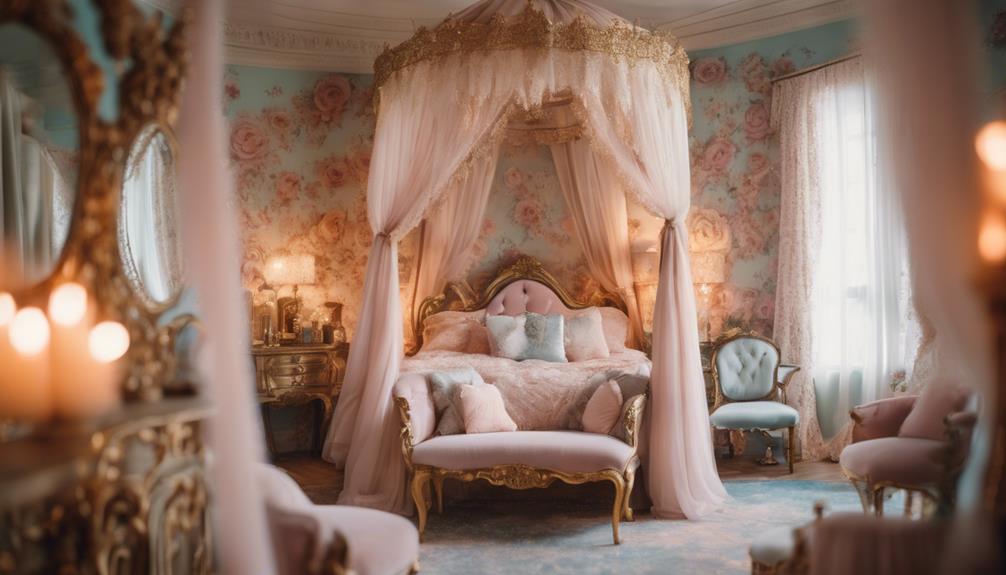
To achieve the perfect coquette bedroom, you'll want to focus on three key elements: color scheme, materials, and textures.
Soft pastels and vintage-inspired pieces will set the tone, while layered textiles add that cozy touch.
Let's explore how these elements work together to create a dreamy space you'll love.
Color Scheme
What colors will you choose to create a dreamy coquette bedroom that captures the essence of soft pastels and romantic accents?
Start with a palette dominated by soft pastels, particularly blush and pastel pink, which will set a warm and inviting tone. These gentle hues create a serene backdrop for the rest of your decor.
Next, consider incorporating warm neutrals like cream and beige to balance the vibrancy of your pastel pink elements. To introduce a touch of romance, accent with bold colors such as hot pink or cherry red. These pops of color can be used in decorative pillows, artwork, or small furnishings.
Don't forget to add muted greens from floral prints to provide contrast and depth, adding a natural element to your space. Light blues and lilacs can also enhance the soft, whimsical vibe while diversifying your color scheme.
Layering these colors with various textures and patterns will create visual interest without overwhelming the pastel theme. This combination will guarantee your coquette bedroom feels cohesive, charming, and undeniably dreamy.
Materials
Incorporating soft fabrics like linen and cotton in pastel shades will create a cozy and inviting atmosphere in your coquette bedroom. Choose bedding and curtains in delicate hues like blush pink, baby blue, or soft lavender to instantly elevate the space. These soft fabrics not only enhance comfort but also embody the romantic essence of coquette room decor.
Next, consider vintage-inspired furniture pieces to complement your choice of materials. A royal vanity table and ornate dressers can infuse a nostalgic charm, making your bedroom feel like a dreamy retreat. You can also enhance the look with decorative accents such as floral patterns, lace trims, and ruffled bedding, adding whimsical elegance to your overall aesthetic.
Accessorizing is key, so opt for elegant mirrors and gilded candle holders that reflect light beautifully, contributing to a warm, inviting glow. Unique vintage finds will further enrich your coquette room decor, making it feel personal and curated.
Textures
Layering various textures is essential for achieving that cozy, inviting vibe in your coquette bedroom. Start with soft fabrics like linen, cotton, and lace, which create a warm atmosphere. Choose ruffled bedding that adds depth and charm, and don't forget plush throw pillows to enhance comfort. Knitted blankets can introduce a homey feel, inviting you to curl up and relax.
Incorporate decorative accents like doilies or embroidered fabrics to bring whimsy and a vintage touch to your space. Opt for floral or pastel-patterned textiles that evoke romance, perfectly aligning with the coquette aesthetic. These elements can create a soft, dreamy environment that feels both personal and inviting.
You can also introduce macramé or crochet wall hangings, which infuse artisanal charm and add dimension to your decor. By thoughtfully layering different textures, you not only enhance the visual appeal but also create a haven of comfort.
Essential Fixtures and Furniture
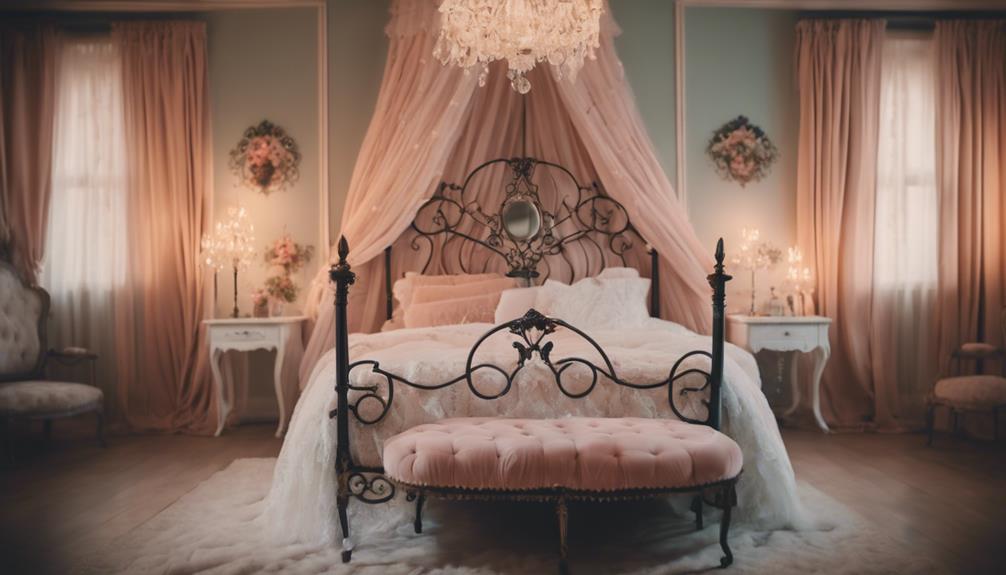
To create the perfect coquette bedroom, you'll want to focus on key pieces like a vintage vanity table, an antique French armchair, and a lace-trimmed bedside table.
These fixtures not only enhance the room's charm but also combine functionality with aesthetic appeal.
Let's explore how each of these elements contributes to your dreamy space.
Vintage Vanity Table
A vintage vanity table adds an elegant focal point to your coquette bedroom, showcasing ornate details and soft pastel finishes that enhance its feminine charm. Look for vintage style vanity tables that feature intricate carvings and decorative hardware. These elements reflect the classic elegance you want in your space.
Opt for soft pastel colors like blush pink or cream to complete the look. A round or oval mirror with a vintage frame is essential, creating a stunning focal point while providing functionality for your beauty routine. This combination not only elevates the aesthetic but also adds depth to the vanity area.
Don't forget about comfort! Consider adding a chair upholstered with velvet or lace accents to complement the overall coquette theme. This touch will invite you to spend time at your vanity.
Storage compartments within the vanity table are also vital for keeping your beauty products and accessories organized. A tidy and aesthetically pleasing space will enhance the overall ambiance of your coquette bedroom, making it a delightful retreat that reflects your personal style.
Embrace these tips to create the vintage-inspired vanity table of your dreams!
Antique French Armchair
An antique French armchair adds a touch of elegance and sophistication to your coquette bedroom, making it a stunning focal point in your decor. With ornate detailing, such as carved wood and graceful curves, this armchair enhances the vintage charm that defines the coquette aesthetic bedroom.
Typically upholstered in soft fabrics like silk, velvet, or linen, these chairs often feature pastel colors or floral patterns that perfectly align with your desired aesthetic. Imagine curling up in this cozy chair with a good book, creating a serene reading nook that invites relaxation.
Incorporating an antique French armchair not only adds style but also functionality to your space. It serves as an accent piece that draws the eye and elevates the overall ambiance.
To complete the look, consider pairing the armchair with complementary decor items, like a gilded mirror or a delicate side table. This harmonious arrangement can further enhance the romantic atmosphere of your coquette bedroom.
Lace-Trimmed Bedside Table
Lace-trimmed bedside tables infuse your coquette bedroom with a charming blend of elegance and femininity, perfectly enhancing its romantic atmosphere. When selecting a bedside table, look for vintage or vintage-inspired pieces that feature intricate carvings and details. These elements not only add character but also align beautifully with the soft pastel color palette typical of the coquette aesthetic.
To elevate the charm of your lace-trimmed table, consider incorporating decorative elements like vintage jewelry trays or small floral arrangements. These accents create a cohesive look, tying in the floral prints you might use in your bedding or curtains.
Soft lighting is essential, so showcase a delicate lamp with a lace shade on your table to create a warm, inviting glow. Mixing materials like wood and lace can add texture and depth to your space, ensuring that your bedside table serves as both a practical fixture and a stylish statement piece.
Lighting Ideas
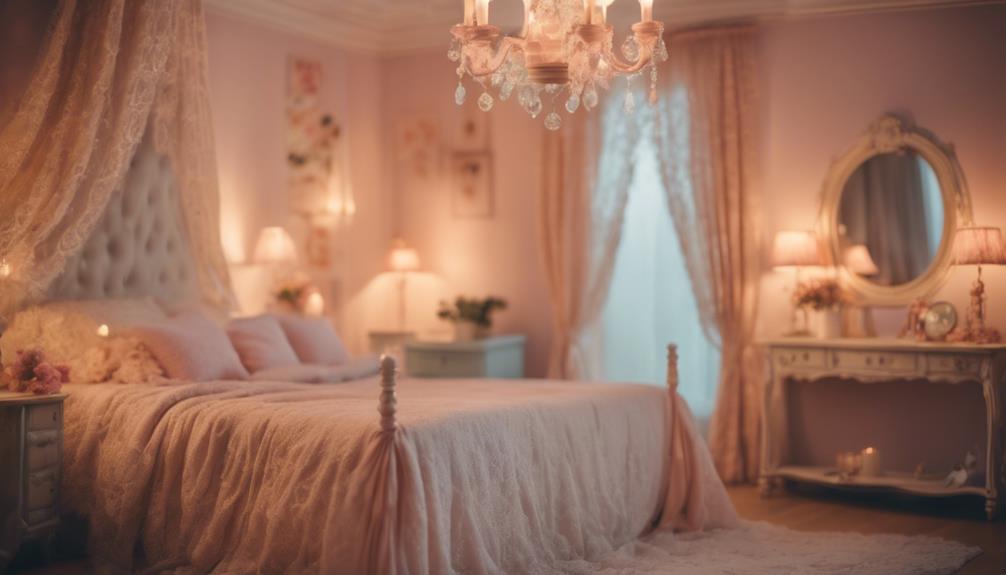
When it comes to lighting in your coquette bedroom, think about adding a chandelier with crystal accents or a vintage crystal pendant light for that touch of elegance.
Soft pink table lamps can create a warm, inviting glow, while fairy string lights add a playful, whimsical charm.
Together, these elements will enhance the romantic atmosphere you're aiming for.
Chandelier With Crystal Accents
Illuminate your coquette bedroom with a chandelier that boasts crystal accents, infusing elegance and vintage charm into the space. A chandelier perfectly aligns with the coquette style, emphasizing femininity and grace. Opt for designs featuring ornate details and soft, warm lighting to create that romantic ambiance you desire.
When choosing your chandelier, look for one with a pastel or gold finish. These colors harmonize beautifully with the coquette color palette, enhancing the overall aesthetic of your bedroom. Consider chandeliers that incorporate floral motifs or whimsical shapes; they'll complement other decorative elements like floral wallpapers and vintage decor, tying the room together seamlessly.
To elevate your lighting experience, install a dimmer switch. This addition allows you to adjust the brightness, helping to set a dreamy and inviting atmosphere that embodies the coquette style.
With the right chandelier, you'll transform your bedroom into a serene retreat that radiates charm and sophistication. So go ahead, choose a chandelier with crystal accents and watch your coquette bedroom come to life!
Soft Pink Table Lamps
Soft pink table lamps add a warm glow to your coquette bedroom, enhancing its romantic vibe while serving as charming accent pieces. These lamps perfectly complement the soft pastel hues that define the coquette aesthetic. When choosing your table lamps, look for delicate designs that feature ruffles, lace, or floral motifs to amplify the feminine charm of your decor.
Adjustable brightness options are a fantastic feature to evaluate, as they create a cozy atmosphere ideal for reading or unwinding. You'll love how the soft pink light transforms your space into a tranquil retreat. Incorporating vintage or antique-style table lamps can further emphasize the nostalgic elements of the coquette bedroom, lending an air of elegance and history.
To create a cohesive look, pair your soft pink lamps with pastel-colored lampshades. This combination not only ties together various decor elements but also enhances the overall aesthetic.
With the right lighting, your coquette bedroom will radiate warmth and charm, making it an inviting sanctuary for relaxation and daydreaming. Embrace these lighting ideas to elevate your space into the epitome of coquette style.
Vintage Crystal Pendant Light
A vintage crystal pendant light instantly elevates your coquette bedroom with elegance and glamour, making it a stunning focal point in your decor. These fixtures often feature intricate designs and sparkling crystals that reflect light beautifully, creating a whimsical atmosphere. When you incorporate a vintage crystal pendant light, you augment the coquette aesthetic, infusing your space with charm and sophistication.
To align with the coquette color palette, consider choosing styles that incorporate soft, pastel-colored crystals or vintage brass finishes. This will guarantee your lighting complements the overall vibe of your bedroom. Installing a vintage crystal pendant light above a vanity or bedside table not only serves as a functional lighting source but also adds a chic decorative element that can tie your entire room together.
You can find many vintage-inspired options through online retailers or local antique shops, allowing you to discover unique pieces that suit your style. With the right vintage crystal pendant light, you'll create an enchanting ambiance that beautifully reflects your personality while enhancing the dreamy allure of your coquette bedroom.
Fairy String Lights
Vintage crystal pendant lights set a glamorous tone, and adding fairy string lights can further enhance the whimsical charm of your coquette bedroom. These enchanting lights provide soft, warm illumination, creating a romantic atmosphere that's perfect for relaxation or intimate gatherings. You can easily drape fairy string lights over furniture, walls, or even a canopy to add layers of charm.
When choosing your fairy string lights, consider options in pastel shades or those featuring floral motifs to align with the coquette aesthetic. Twinkling or color-changing lights can elevate the ambiance, evoking a dreamy, nostalgic feel that's both whimsical and romantic.
To achieve a cohesive look, pair your fairy string lights with sheer curtains or delicate wall decor. This combination accentuates the lights' glow while enhancing the overall aesthetic of your space.
Decorative Elements
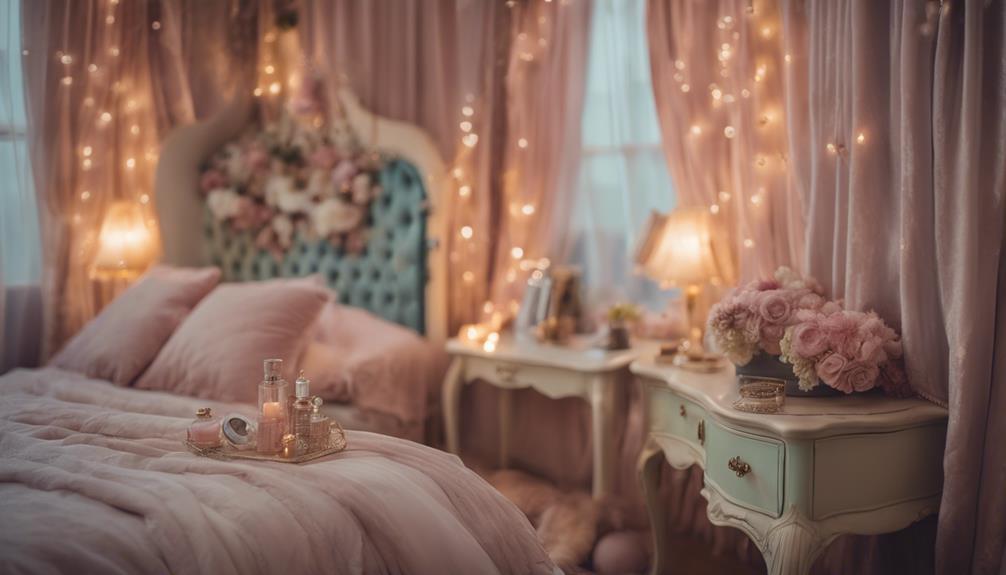
When it comes to decorative elements, consider incorporating floral embroidered throw pillows to add that charming touch to your bed.
A vintage porcelain figurine can serve as a lovely focal point, bringing character to your space.
Floral Embroidered Throw Pillows
Floral embroidered throw pillows instantly elevate your coquette bedroom with their whimsical charm and soft textures. These pillows not only enhance your coquette aesthetic room decor but also bring a delightful touch of femininity. Opt for options that feature pastel colors and intricate floral patterns, as these elements align perfectly with the vintage appeal of the coquette style.
To add visual interest and depth, incorporate various sizes and shapes of floral embroidered throw pillows. Mixing and matching different textures, like plush throws or silky bedding, creates a cozy atmosphere that invites relaxation. Look for pillows adorned with lace or ruffle trims; these details reinforce the dainty elegance that's characteristic of coquette design.
Don't hesitate to layer your pillows on your bed or seating area for a more inviting look. The combination of these decorative elements will transform your space into a charming retreat. Remember, the key is to create a harmonious blend of colors and patterns, making your coquette bedroom a true reflection of your style while celebrating the beauty of floral embroidered throw pillows.
Vintage Porcelain Figurine
Incorporating porcelain figurines into your coquette bedroom instantly elevates the decor, adding a charming touch that complements the overall aesthetic. Vintage porcelain figurines often depict delicate themes like ballerinas or floral motifs, perfectly resonating with the romantic and whimsical vibe of coquette decor.
These figurines serve as beautiful focal points on shelves, dressers, or nightstands, enhancing the elegance of your space. Look for pieces in soft pastel colors or intricate designs to align with the coquette color palette of blush pinks, creams, and light blues. By collecting vintage porcelain figurines from different eras, especially from the 1950s and 1960s, you can create a curated look that emphasizes the vintage charm essential to this aesthetic.
To keep your vintage porcelain figurines looking their best, dust them regularly and handle them with care. This attention to detail guarantees they remain a cherished part of your decor, adding a timeless quality to your coquette bedroom.
Delicate Lace Table Runner
A delicate lace table runner instantly uplifts your coquette bedroom, infusing it with elegance and a feminine touch that perfectly complements the romantic vibe.
When choosing your lace runner, opt for soft pastel colors like blush pink or creamy white. These hues harmonize beautifully with the dreamy color palette typical of the coquette aesthetic.
Look for intricate lace patterns that evoke vintage charm. This detail can turn your table runner into a stunning focal point on dressers or bedside tables.
To enhance the delicate design, layer the lace table runner over a solid-colored fabric. This contrast not only adds depth to your decor but also highlights the intricate lacework.
Consider using the delicate lace table runner as a base for displaying decorative accents like candles, flowers, or vintage trinkets. This approach allows you to further enhance the coquette aesthetic while creating visually appealing arrangements.
Flooring
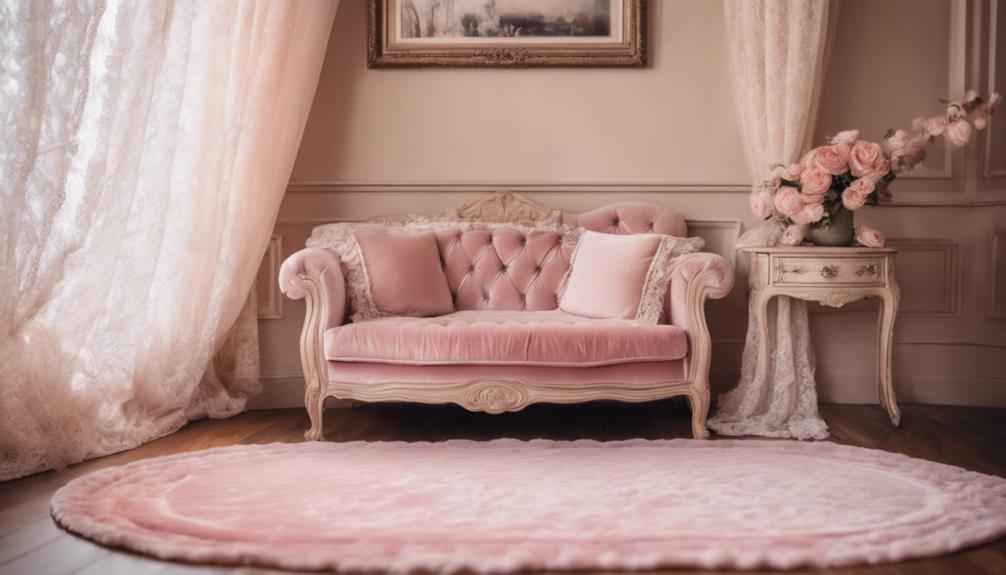
When it comes to flooring in your coquette bedroom, soft, pastel-colored area rugs can set the perfect tone.
Consider adding a cream lace patterned carpet or a rose petal print area rug to enhance the feminine charm and warmth.
These choices won't only elevate the aesthetic but also provide comfort underfoot.
Soft, Pastel-Colored Area Rug
Soft, pastel-colored area rugs effortlessly enhance the coquette bedroom's charm with their gentle hues and inviting textures. When choosing a rug, look for soft shades like blush, lavender, or mint green that complement your overall decor. These pastel tones not only add a splash of color but also create a serene atmosphere that's perfect for a coquette aesthetic.
Consider selecting rugs with delicate patterns, such as florals or subtle geometric designs, to maintain that whimsical coquette vibe while also introducing texture. A plush pile or shag option can further elevate the coziness of your space, making it feel warm and inviting.
It's essential to pick a size that works for your room. Ideally, the rug should extend under key furniture pieces like your bed or seating area to unify the space and enhance the coquette look. This helps in defining areas within the room, making it feel more cohesive.
Cream Lace Patterned Carpet
Cream lace patterned carpet brings a romantic charm to your coquette bedroom, effortlessly enhancing its feminine aesthetic. This delicate design adds a soft touch while maintaining a neutral color palette, making it a perfect complement to your pastel decor items.
Opting for a plush material means you'll enjoy increased comfort and warmth, inviting you to relax in your cozy space. The cream tones in the carpet reflect light beautifully, creating an airy, bright atmosphere that's essential for coquette decor.
Moreover, a cream lace patterned carpet serves as a subtle backdrop for showcasing vintage furniture and decorative accents, allowing them to shine without overpowering the room. You can play with textures by mixing the carpet with lace or silk accents elsewhere in the room, creating a cohesive look that's both chic and inviting.
When you choose this type of carpet, you're not just flooring your coquette bedroom; you're establishing a foundation of romantic elegance that ties all your decor together. Embrace the charm of a cream lace patterned carpet and transform your space into a dreamy retreat.
Rose Petal Print Area Rug
A rose petal print area rug adds an enchanting focal point to your coquette bedroom, instantly elevating the romantic vibe with its whimsical floral design. This stunning piece can tie together your decor elements, seamlessly blending with floral bedding and vintage furniture for a charming look.
When choosing your rug, opt for soft, plush materials like polyester or wool. These fabrics not only add comfort but also enhance the cozy atmosphere of your coquette bedroom. Look for rugs in pastel shades, such as blush pink or soft cream, to align with the delicate color palette often found in this aesthetic.
Safety is key, so consider a rug with a non-slip backing, especially if your bedroom experiences high foot traffic. This feature guarantees stability while you move about your space.
Incorporating a rose petal print area rug into your bedroom design creates a delightful focal point that enhances the overall romantic ambiance. With its charming design and soft textures, this rug will make your coquette bedroom feel inviting and beautifully coordinated.
How can I incorporate natural elements into my coquette bedroom decor to create an aesthetic and calming space?
When it comes to incorporating natural elements home decor into your coquette bedroom, think about adding plants, wooden furniture, and soft, earthy color palettes. These elements can help create an aesthetic and calming space that brings a touch of nature indoors.
Conclusion
Creating an aesthetic coquette bedroom is all about blending charm, comfort, and a touch of whimsy.
By thoughtfully selecting key elements, essential fixtures, and lighting, you can craft a space that feels uniquely yours.
Don't forget to add decorative touches and consider your flooring to complete the look.
With these tips and inspiration, you're well on your way to designing a dreamy retreat that reflects your personality and style.
Happy decorating!
